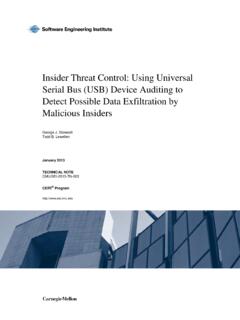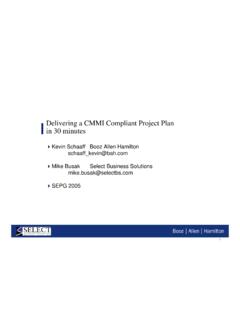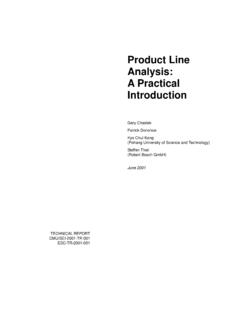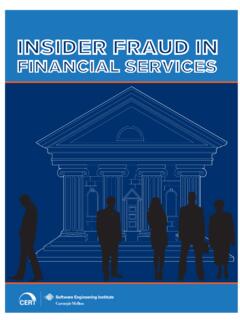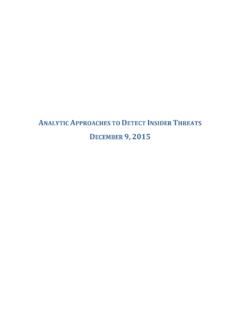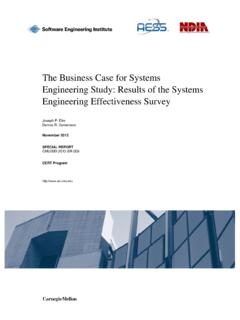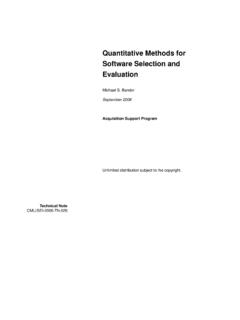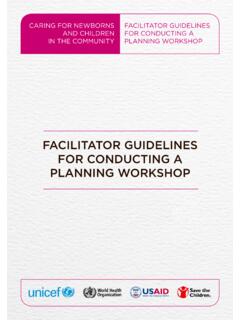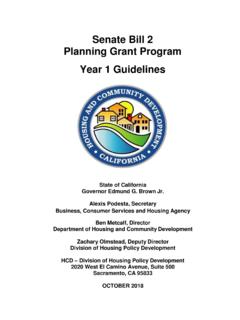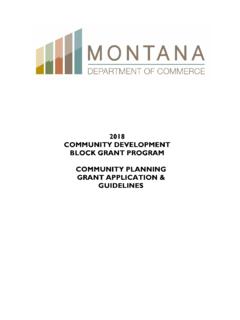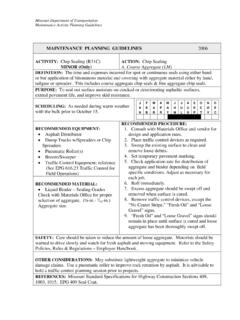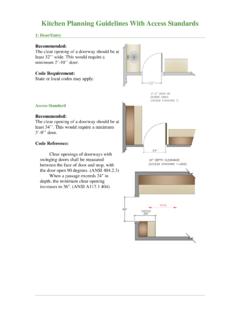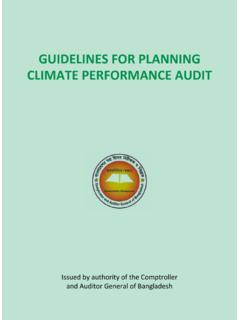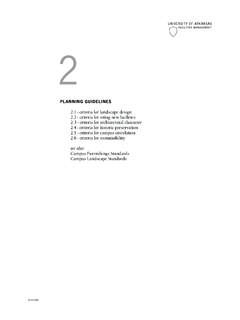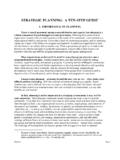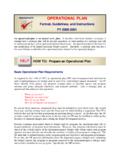Transcription of Software Acquisition Planning Guidelines - SEI Digital Library
1 Software Acquisition Planning guidelineSCMU/SEI-2005-HB-006 Editor: William E. NovakContributors:Julie B. CohenAnthony J. LattanzeLinda Levine, PhDWilliam E. NovakPatrick R. H. PlaceRay C. WilliamsCarol Woody, PhDDecember 2005 Acquisition Support ProgramUnlimited distribution subject to the ideas and findings in this report should not be construed as an official DoD position. It is published in the interest of scientific and technical information Software Engineering Institute is a federally funded research and development center sponsored by the Department of 2005 Carnegie Mellon WARRANTYTHIS CARNEGIE MELLON UNIVERSITY AND Software ENGINEERING INSTITUTE MATERIAL IS FURNISHED ON AN AS-IS BASIS.
2 CARNEGIE MELLON UNIVERSITY MAKES NO WARRANTIES OF ANY KIND, EITHER EXPRESSED OR IMPLIED, AS TO ANY MATTER INCLUDING, BUT NOT LIMITED TO, WARRANTY OF FITNESS FOR PURPOSE OR MERCHANTABILITY, EXCLUSIVITY, OR RESULTS OBTAINED FROM USE OF THE MATERIAL. CARNEGIE MELLON UNIVERSITY DOES NOT MAKE ANY WARRANTY OF ANY KIND WITH RESPECT TO FREEDOM FROM PATENT, TRADEMARK, OR COPYRIGHT of any trademarks in this report is not intended in any way to infringe on the rights of the trademark use. Permission to reproduce this document and to prepare derivative works from this document for internal use is granted, provided the copyright and No Warranty statements are included with all reproductions and derivative use.
3 Requests for permission to reproduce this document or prepare derivative works of this document for external and commercial use should be addressed to the SEI Licensing work was created in the performance of Federal Government Contract Number FA8721-05-C-0003 with Carnegie Mellon University for the operation of the Software Engineering Institute, a federally funded research and development center. The Government of the United States has a royalty-free government-purpose license to use, duplicate, or disclose the work, in whole or in part and in any manner, and to have or permit others to do so, for government purposes pursuant to the copyright license under the clause at information about purchasing paper copies of SEI reports, please visit the publications portion of our Web site ( ).
4 Software Acquisition Planning Guidelines iTable of 1: Open Systems Contributor: Patrick R. H. Place GUIDELINE 2: Commercial Off-The-Shelf (COTS)-Based Contributor: Dynamic Systems ProgramGUIDELINE 3: Software Contributor: Anthony J. LattanzeGUIDELINE 4: Software Contributor: William E. NovakGUIDELINE 5: Requirements Contributor: Software Engineering Process Management ProgramGUIDELINE 6: Requirements Contributor: Software Engineering Process Management ProgramGUIDELINE 7: Operational Information Contributor: Carol Woody, PhDGUIDELINE 8: Information Assurance for COTS Contributor: Carol Woody, PhDGUIDELINE 9: Information Asset Contributor: Carol Woody, PhDGUIDELINE 10: Software Contributor: Julie B.
5 Cohen GUIDELINE 11: Software Risk Contributor: Ray C. Williams GUIDELINE 12: Software Contributor: Software Engineering Measurement and Analysis Initiative GUIDELINE 13: Software -Based Award Contributor: Julie B. Software Acquisition Planning Guidelines Table of ContentsSoftware Acquisition Planning Guidelines iiiAcknowledgments Many people have contributed to creating these Guidelines , both directly and indirectly. It would not have been possible to provide guidance on such a wide range of Software Acquisition topics without the combined expertise and prior work of many others. We would like to thank our sponsor, the United States Army Strategic Software Improvement Program (ASSIP), for the opportunity to perform this work.
6 We would like to thank the Software Engineering Institute (SEI) research programs that have researched, developed, and published the work and ideas represented here, including the Acquisition Support Program, Dynamic Systems Program, Networked Systems Survivability Program, Product Line Systems Program, and the Software Engineering Process Management Program. In particular, the editor would like to thank Joseph Elm, Julie Cohen, Jeannine Siviy, Wolfhart Goethert, Mary Catherine Ward, Ray Williams, and the many other authors and contributors to the SEI s Software Acquisition Survival Skills course, on which several of the Guidelines are based. We are also indebted to Lisa Brownsword, Patricia Oberndorf, and Dr.
7 Carol A. Sledge for their work in developing the SEI s COTS-Based Systems for Program Managers course. We would also like to thank all of the people within the SEI who provided technical review and comment, including: Cecilia Albert, John Bergey, Julie Cohen, Robert Ferguson, Donald Firesmith, Mary Ann Lapham, B. Craig Meyers, Patricia Oberndorf, Patrick Place, John Robert, and Ray Williams. Due to their efforts and expertise, this is a much better document. Finally, the authors are most grateful for the essential help we have received from our editor, Susan Kushner, and our document designers, Stacy Mitchell and Melissa Neely. Their efforts have resulted in a clearer and simpler document.
8 Iv Software Acquisition Planning GuidelinesAcknowledgmentsSoftware Acquisition Planning Guidelines vAbstract Guidance about Acquisition Planning and strategy is scattered by topic throughout many different books, reports, presentations, and Web sites. This handbook presents guidance for Acquisition Planning and strategy topics in a condensed form, and references the primary resources available for each topic. The topics for the Guidelines in this handbook represent selected areas in which the SEI has conduct-ed significant research. The Guidelines are organized by the Acquisition strategy considerations categories from the Defense Acquisition University s Defense Acquisition Guidebook that describe the principal areas of consideration for Planning an Acquisition strategy.
9 Guidance is offered on 13 top-ics, including open systems approach, commercial off-the-shelf (COTS)-based systems, Software architecture, Software sustainment, requirements development, requirements management, operational information assurance, information assurance for COTS sustainment, information asset protection, Software testing, Software risk management, Software metrics, and Software -based award fees. This handbook is intended to provide program managers and project management office staffs with recommendations and resources for addressing different aspects of their Acquisition strategy. It illustrates Acquisition challenges with program scenarios, suggests actions that should be taken, and identifies danger signs to look for when evaluating progress.
10 A basic knowledge of both Software development and Acquisition practices is Software Acquisition Planning GuidelinesAbstractSoftware Acquisition Planning Guidelines 1 Introduction Good judgment is usually the result of experience. And experience is frequently the result of bad judgment. But to learn from the experience of others requires those who have the experience to share the knowledge with those who follow. Barry LePatner BACkGROUND AND RATIONALEThe Software Acquisition practitioners assigned to government Program Management Offices (PMOs) have policy and regulations they must follow, but they also need concise, practical guidance to assist them. Good information on Acquisition Planning and strategy is available, but it is scattered by topic across many different publications.
